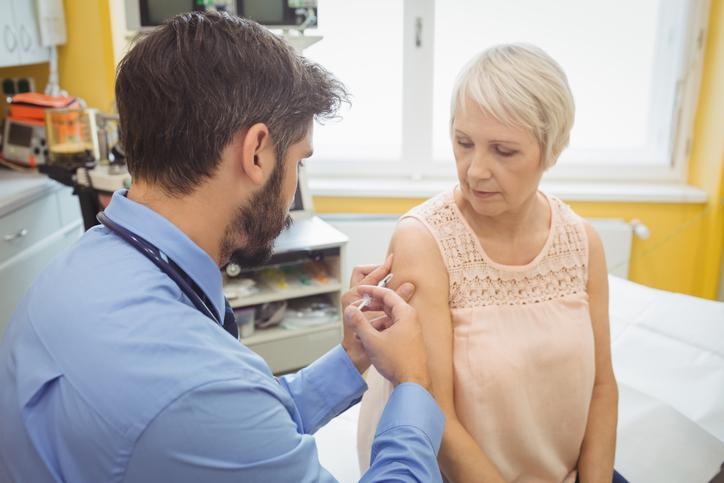The adjuvanted influenza and adjuvanted shingles vaccines can be safely administered at the same time, a randomized, blinded clinical trial concludes.
Duke University investigators compared the safety of and reactions to simultaneous intramuscular vaccination with the quadrivalent (four-strain) inactivated adjuvanted flu vaccine (allV4) and the adjuvanted recombinant herpes zoster (shingles) vaccine (RSV) with that of simultaneous administration of the RZV and quadrivalent high-dose inactivated nonadjuvanted flu vaccine (HD-IIV4) vaccines.
allV4 or HD-IIV4 is recommended for adults aged 65 years and older and the shingles vaccine for those aged 50 and older.
"Novel nonaluminum adjuvants are powerful immunostimulants used in vaccine platforms to improve immunogenicity and efficacy," the researchers wrote. "Vaccines with novel adjuvants are more reactogenic than vaccines without adjuvants, and there is a theoretical possibility that novel adjuvants could activate immune mediated disease in some individuals."
The findings were published today in JAMA Network Open.
Vaccines given in each arm
The team vaccinated 130 community-dwelling adults 65 years and older with one dose each of RZV and allV4 in opposite arms and gave the RSV and HD-IIV4 vaccines to 137 during the 2021-22 and 2022-23 flu seasons at two US Centers for Disease Control and Prevention (CDC) Immunization Safety Assessment (CISA) Project sites at Duke and Johns Hopkins universities. Health-related quality of life (HRQoL) was evaluated for 7 days postvaccination.
The second RZV dose was given alone on day 60. The median participant age was 71 years, 51.3% were men, and follow-up was roughly 3 months.
Outcomes of interest were the proportion of vaccinees with at least one severe solicited local or systemic reaction in the 8 days after vaccination and serious adverse events and adverse events of clinical interest in the 43 days after vaccination.
Slightly fewer severe reactions after adjuvanted flu vaccine
The percentage of participants who reported one or more severe reactions after simultaneous vaccination with RZV and allV4 (11.5%) was noninferior compared with simultaneous vaccination with RZV and HD-IIV4 (12.5) (absolute difference, -1.0% (95% confidence interval [CI], -8.9% to 7.1%).
From a safety standpoint, this study supports the simultaneous administration of RZV and allV4 among older adults.
The proportion of participants with at least one severe local reaction was noninferior in the RZV and allV4 group (6.2%) compared with the RZV and HD-IIV4 group (4.4%) (absolute difference, 1.7%; 95% CI, -4.0% to 7.8%). And the percentage reporting one or more severe systemic reactions was noninferior in the RZV and allV4 group (5.4%) compared with the RZV and HD-IIV4 group (9.6%) (absolute difference, -4.2%; 95% CI, -10.9% to 2.5%).
Throughout the study period, nine serious adverse events were reported (3.1% in the RZV and allV4 group and 3.7% in the RZV and HD-IIV4 group).
No participant sought medical care for a local or systemic reaction in the 8 days after dose 1 or 2 of RZV, and patterns of severe reactions among participants aged 65 to 69 years were similar to those of participants aged 70 and older.
In the 43 days postvaccination, 0.8% of participants in the RZV and allV4 group had a serious adverse event, compared with 3.7% in the RZV and HD-IIV4 group (difference between the allV4 and HD-IIV4 groups, –2.9%; 95% CI, -6.4% to 0.6%). There were minimal changes to HRQoL scores in the 8 days after vaccination.
"Overall safety findings were similar between groups," the study authors wrote. "From a safety standpoint, this study supports the simultaneous administration of RZV and allV4 among older adults."





















